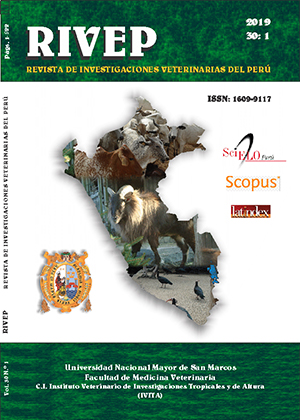Molecular detection of Bluetongue virus in Culicoides insignis and sheep of Pucallapa, Peru
DOI:
https://doi.org/10.15381/rivep.v30i1.15690Keywords:
Culicoides spp; antibodies; Seg 7; Bluetongue virus; jungleAbstract
The aim of the present study was to detect the RNA of the Bluetongue virus (BTV) in Culicoides insignis and in blood samples of sheep reared under an extensive production system in Pucallpa, Peru. In a first phase, sheep blodd samples (n=46) were obtained from three farms to detect serum antibodies against BTV by agar gel immunodiffusion (AGID) and a competitive ELISA. Results showed that 46.7, 81.3 and 20.0% of sheep had antibodies by IDGA, of which 96% were positive to antibodies against VTV by the ELISA test. In the second phase, 1143 Culicoides spp were captured and 15 sheep blood samples were collected in the seropositive farms. One thousand females of Culicoides insignis were identified. The females were grouped into pools of 100 each (C. insignis = 10 pools and Culicoides spp = 1). For the molecular analysis, the extraction of total RNA was carried out from the ovine blood samples and Culicoides, followed by a nested PCR using two pairs of specific primers that amplified seg 7 of BTV. Only one pool of C. insignis and one sheep blood sample showed a band of approximately 1070 bp. The presence of viral RNA in the pool of C. insignis and in the ovine suggest the possible role of C. insignis as a potential vector for the transmission of BTV in sheep of the farms under study.
Downloads
Downloads
Published
Issue
Section
License
Copyright (c) 2019 Miguel Rojas M., Dennis Navarro M., Jessica Jurado P., Alberto Manchego S., Mercy Ramírez V., Ana Karina Castillo E., Hermelinda Rivera G.

This work is licensed under a Creative Commons Attribution-NonCommercial-ShareAlike 4.0 International License.
AUTHORS RETAIN THEIR RIGHTS:
a. Authors retain their trade mark rights and patent, and also on any process or procedure described in the article.
b. Authors retain their right to share, copy, distribute, perform and publicly communicate their article (eg, to place their article in an institutional repository or publish it in a book), with an acknowledgment of its initial publication in the Revista de Investigaciones Veterinarias del Perú (RIVEP).
c. Authors retain theirs right to make a subsequent publication of their work, to use the article or any part thereof (eg a compilation of his papers, lecture notes, thesis, or a book), always indicating the source of publication (the originator of the work, journal, volume, number and date).










